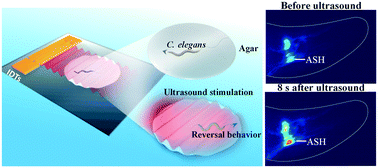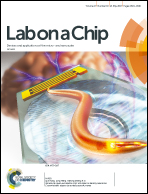Ultrasound neuro-modulation chip: activation of sensory neurons in Caenorhabditis elegans by surface acoustic waves†‡
Abstract
Ultrasound neuro-modulation has gained increasing attention as a non-invasive method. In this paper, we present an ultrasound neuro-modulation chip, capable of initiating reversal behaviour and activating neurons of C. elegans under the stimulation of a single-shot, short-pulsed ultrasound. About 85.29% ± 6.17% of worms respond to the ultrasound stimulation exhibiting reversal behaviour. Furthermore, the worms can adapt to the ultrasound stimulation with a lower acoustic pulse duration of stimulation. In vivo calcium imaging shows that the activity of ASH, a polymodal sensory neuron in C. elegans, can be directly evoked by the ultrasound stimulation. On the other hand, AFD, a thermal sensitive neuron, cannot be activated by the ultrasound stimulation using the same parameter and the temperature elevation during the stimulation process is relatively small. Consistent with the calcium imaging results, the tax-4 mutants, which are insensitive to temperature increase, do not show a significant difference in avoidance probability compared to the wild type. Therefore, the mechanical effects induced by ultrasound are the main reason for neural and behavioural modulation of C. elegans. With the advantages of confined acoustic energy on the surface, compatible with standard calcium imaging, this neuro-modulation chip could be a powerful tool for revealing the molecular mechanisms of ultrasound neuro-modulation.



 Please wait while we load your content...
Please wait while we load your content...